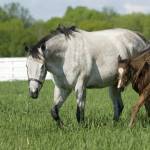Giardiasis in Horses: An Underreported Threat?

When horse owners think of internal parasites, visions of wiggly roundworms, squirmy strongyles, and itchy, pesky pinworms often swarm before our eyes. Rarely do we consider Giardia, small, flagellated protozoal organisms that infect the small intestine of mammals, including horses. Recent research in several countries, however, suggests that infection with Giardia, known as giardiasis, is more common than we think, putting young foals and their human handlers at risk.
“Infected mammals, both wild and domestic, shed Giardia cysts in their feces. Those cysts are hardy and immediately infective, which means that if another mammal is grazing, for example, and ingests those cysts, it can become infected,” says Peter Huntington, B.V.Sc., M.A.C.V.Sc., director of nutrition at Kentucky Equine Research (Australia).
After horses ingest Giardia cysts, the parasite hatches or encysts, gaining the ability to mobilize and attach to the lining of the wall of the small intestine. Once attached, it begins pilfering nutrients and reproducing, some of which form cysts excreted in the horse’s feces.
Historical data indicate that approximately 0.5-35% of horses worldwide are infected with Giardia duodenalis, the most common species of Giardia to infect horses, humans, dogs, and cats. One recent study* found 14.2, 11.4, 10, and 11.6% of 398 tested foals from Belgium, The Netherlands, Germany, and Greece were found to be excreting Giardia cysts. Some foals shed only small numbers of cysts (50/gram of feces), but others shed up to 4 million infectious cysts/gram of feces.
“That study also reported that, similar to other internal parasites, younger horses are more likely to be infected with Giardia. Specifically, foals 1-30 days of age were more commonly infected (55.6% infection rate) compared to only 6.7% of foals aged 91-120 days,” reports Huntington.
Other facts about giardiasis:
1. Giardiasis is zoonotic, which means that humans exposed to infected animals are at risk of developing the infection themselves.
2. Giardia can cause diarrhea, ill thrift, poor hair coats, weight loss, and other common signs of intestinal parasitism.
3. Some infected foals shedding Giardia cysts might not show overt signs of diarrhea but are still capable of infecting other animals, including humans, on the premises.
This sets up a farm for a continuous cycle of transmission, especially when overcrowding is an issue.
“It appears, based on recent research, that foals are frequently infected but don’t always show clinical signs such as diarrhea; are often capable of clearing the infection naturally as they age; and that, in general, pose only a minor risk to other foals, horses, farm animals, and humans,” said Huntington.
“Nonetheless, horses of any age can be infected and develop diarrhea; therefore, giardiasis should be considered whenever a horse has diarrhea. Handlers should be encouraged to practice best hand-hygiene practices to avoid ‘beaver fever,’ the colloquial term for profuse diarrhea caused by Giardia in humans,” concludes Huntington.
*Kostopoulou, D., S. Casaert, N. Tzanidakis, et al. 2015. The occurrence and genetic characterization of Cryptosporidium and Giardia species in foals in Belgium, The Netherlands, Germany and Greece. Veterinary Parasitology 211(3-4):170-174.








